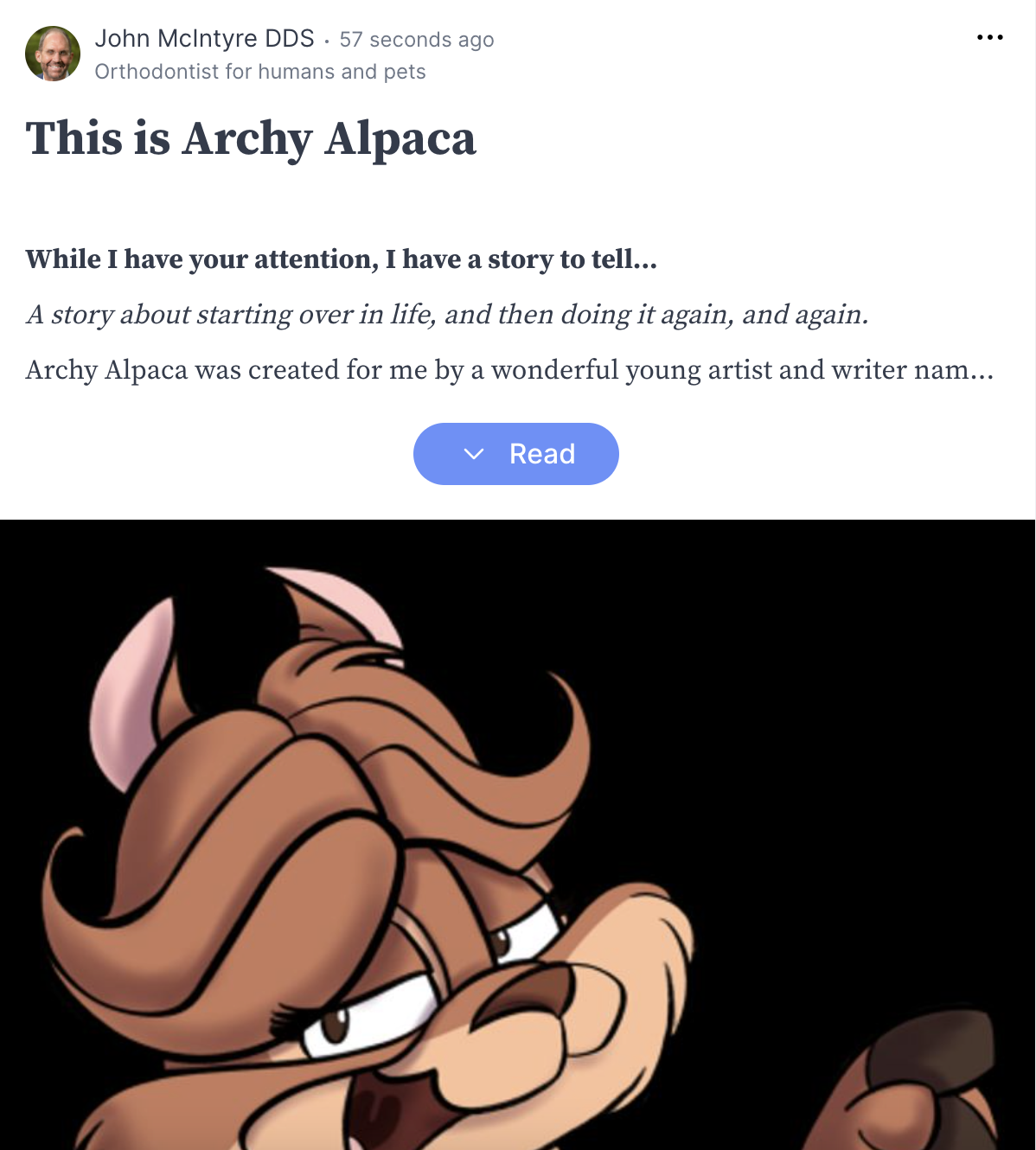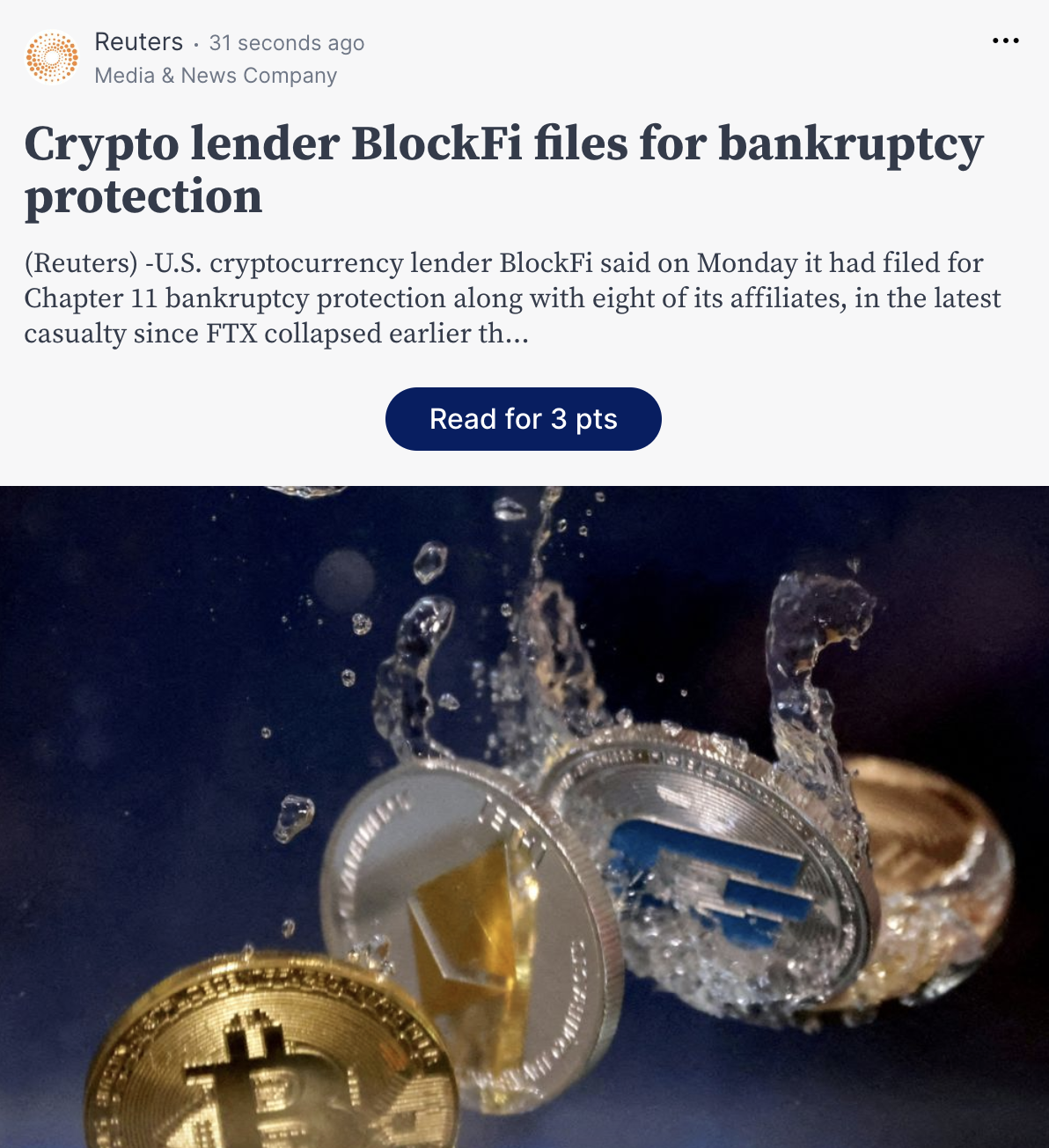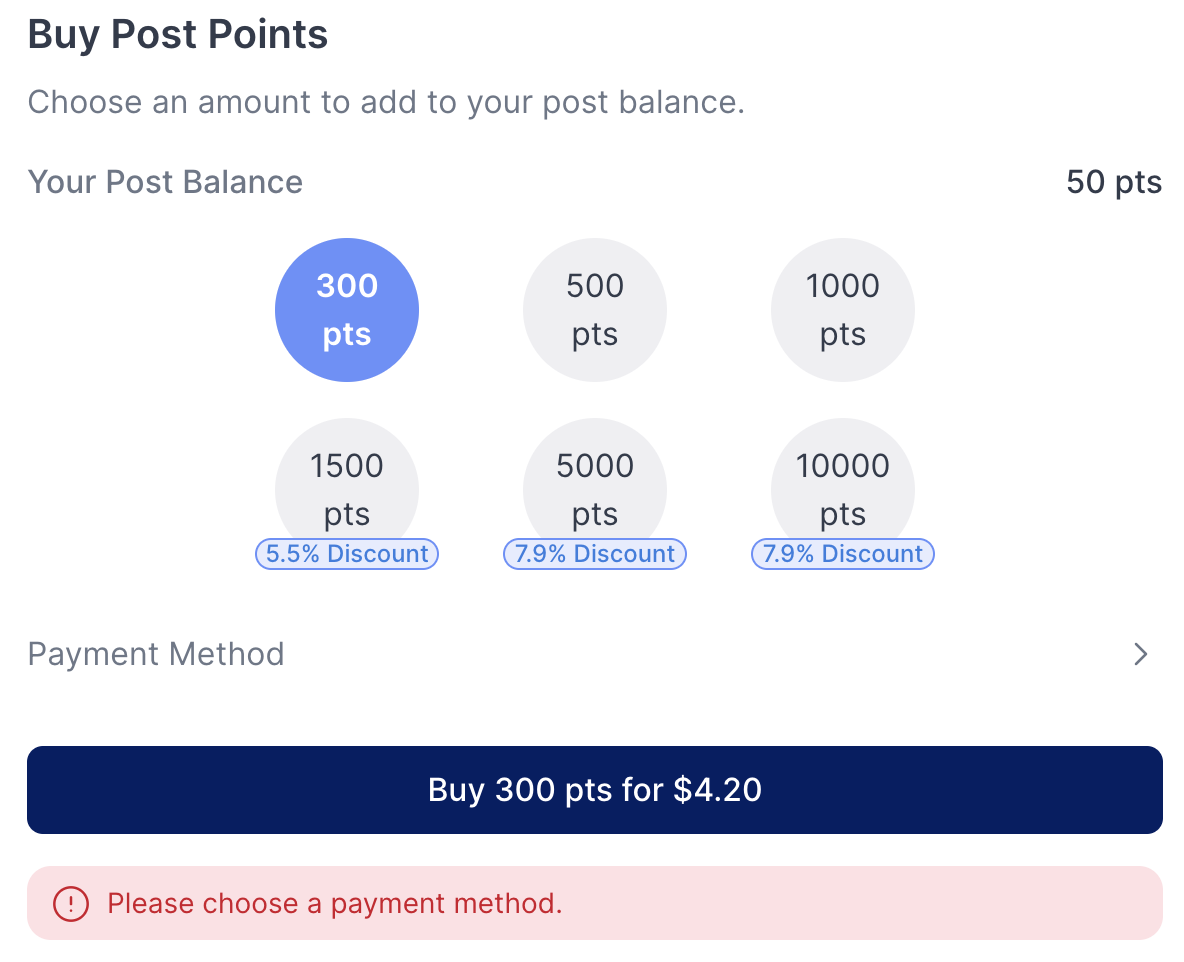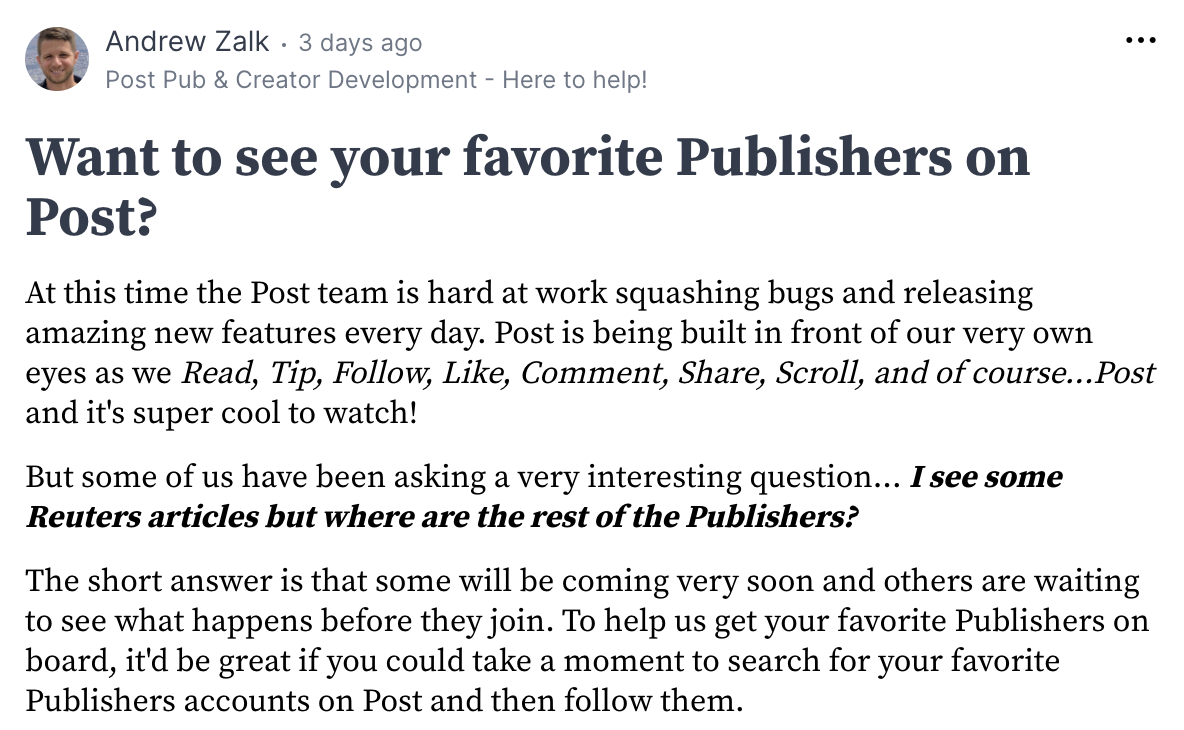
When I opened Post.news on Monday morning, the top story in my Explore feed was an inspirational story about a cartoon alpaca. Further down, I saw huge photos of dogs, inspirational memes, a bunch of people’s thoughts about Twitter, screenshots of tweets, and plenty of “Hello, world.”
 But Post has bigger ambitions. The “social platform for real people, real news, and civil conversations,” was founded by former Waze CEO Noam Bardin. It counts Kara Swisher as an advisor and venture capital firm Andreessen Horowitz as one of its two investors. The other investor is Scott Galloway, an NYU professor and cohost of the Pivot podcast with Swisher. “I’ve never seen anyone, except maybe at a few strip bars, throw more money at someone than they’re throwing at Noam Bardin right now,” Galloway said on an episode of the Pivot podcast last week, in which he and Swisher interviewed Bardin. (Bardin wrote that, beyond funds from Andreessen Horowitz and from Galloway, “the only other money invested is mine.”)
But Post has bigger ambitions. The “social platform for real people, real news, and civil conversations,” was founded by former Waze CEO Noam Bardin. It counts Kara Swisher as an advisor and venture capital firm Andreessen Horowitz as one of its two investors. The other investor is Scott Galloway, an NYU professor and cohost of the Pivot podcast with Swisher. “I’ve never seen anyone, except maybe at a few strip bars, throw more money at someone than they’re throwing at Noam Bardin right now,” Galloway said on an episode of the Pivot podcast last week, in which he and Swisher interviewed Bardin. (Bardin wrote that, beyond funds from Andreessen Horowitz and from Galloway, “the only other money invested is mine.”)
Bardin wrote on Monday that Post has approved around 65,000 users out of a wait list of 335,000.
I used Twitter, posts on Post, and Swisher and Galloway’s podcast interview with Bardin to get some insight into how the company is thinking about news.
“We want to allow you to read premium news from multiple publishers,” Bardin wrote in a post on Sunday.
So far, the only publisher I’ve seen with content for “sale” on the platform is Reuters, which invites users to read its articles using “points.” (Each Post News user is given 50 points at sign-up.) Reuters is posting all its articles to Post News. But all these same articles are free on Reuters’ website, so I’m not sure why anyone would pay for them, even with imaginary free points.

This is quite a thing for Post News to claim when right now the only premium news provider I've found is Reuters, who is republishing wire stories you can read for free on their website for money while WSJ has uhhh this. https://t.co/hgPHWDXMg1 pic.twitter.com/swjkLVvpgm
— Aram Zucker-Scharff | @Chronotope@indieweb.social (@Chronotope) November 25, 2022
Ultimately, the vision seems to be that Post will allow users to pay micropayments for individual articles on Post. It’s a setup that Bardin says is good for both publishers and for itself, so I imagine he’s envisioning a revenue share, though he doesn’t say that explicitly. Here’s Bardin talking about the business model on the Pivot podcast (emphases mine):
I’ve been obsessing, the last, like six years, about this triangle between publishing and news journalism, social media networks, and the changing consumer behavior. And these three things have been working together, I believe, to bring us to the worst possible place.
News has moved to subscription, which basically converts maybe 2% of the users and so blocks 98% of the users from getting real editorialized content. Consumers have changed their behavior. They want to consume their news in their feed. And so, obviously, consumption from a feed does not work with subscription. And social media networks, with their advertising-based model, promote the worst in us because it works. I mean, the algorithms are don’t really care. They just, you know, try to achieve the engagement at any cost, right?
I spent a lot of time since I left Google about two years ago, building different products in this space, trying different things, and finally realized there’s no choice but to build something new, and what I’ve realized is that there’s a moment of opportunity now, and it’s wider than just what’s going on on Twitter, right? Facebook basically decided to drop news, move it out of the News Feed, and then stop paying news organizations. On the legal side, regulators are trying to force platforms to pay publishers. There’s this whole ecosystem of — where does news fit in? — that is kind of broken today…
What I believe consumers want is to be able to get multiple sources of news in their feed — some from creators or from people, some from professional journalists. They are willing to pay something for it. It doesn’t have to be free if you want good-quality news, but that doesn’t mean you’re going to subscribe to every publication. The fact that every publication thinks you’re gonna subscribe to it just mathematically can’t work, right? Obviously, that’s not going to work. So we need other models and we can’t have a world of just advertising or subscription. […]
We want to be able to bring the right content to the right user at the right price. And that means that if you come on the platform, spend 15 minutes, walk away feeling smarter, that’s success. But it also means that our incentives are aligned with content creators’, whether it’s publishers or individual content creators. We both make money or we don’t make money, unlike today where the platforms make a lot of money, but the publishers and the creators make nothing. […]
Let’s start, always, from the consumer. By the way, that’s one of the problem with publishers: They don’t talk about the consumer at all. It’s not part of their DNA. They’re saving the world. But when it comes from the consumer perspective, right, the modern consumer wants to get multiple sources in their feed. Why can’t you do that today? Because every time you click on it, you hit a paywall, and you’re not gonna subscribe to everything, right?
And so this means that publishers are losing 98% of the traffic. Now, the 2% that subscribe are obviously very, very valuable for them. So this means from a newsroom perspective, they end up writing for that 2%, which are the most extreme and politically aligned group, and they’re not writing for the average. And if they could hear — hear, in terms of monetization — the requests of the average, I believe it would also impact dramatically what they cover and how they cover it.
So in my view, you’re going through your [Post] feed, you see an article from The Washington Post on inflation, you click on it, and you read it. No friction. Friction is our biggest enemy, right? One click, you pay for it, you read it. The next article coming in might be The Wall Street Journal on inflation, because your feed has been changing based on what you’re reading. And you’re gonna read that suddenly. So suddenly, you’ve read two different takes on inflation in your feed, but you’re not subscribed to either of them. But the publisher can set the price. They can set the terms.
There are a few questionable statements here: It isn’t true that consumers can’t get multiple sources of news in a feed. They can! On Twitter, for instance, or on Apple News+.
It also isn’t true that you hit a paywall as soon as you click on a link to an article from a news outlet you don’t subscribe to. Most news outlets give you a bunch of free articles; local news sites are worse about this, but the two news sources that Bardin mentions, The Washington Post and The Wall Street Journal, definitely let you read plenty of stuff for free.
And it isn’t true that publishers don’t talk about the consumer “at all” — as publishers become more reliant on subscriptions, most are talking about audiences constantly. (Maybe Bardin is referring here to “the consumer” as someone somehow separate from “the subscriber,” i.e., a person who will absolutely never pay to subscribe?)
I’m also generally skeptical of the notion that the average news consumer wants to read — and pay for — takes from multiple political perspectives on an issue like inflation, though It’s unclear here if Bardin is referring to politics, specifically.
But who does Bardin think the average news consumer is? Later in the podcast, he speaks about that:
I want to care about the 75% of users that today on Twitter don’t tweet. They really are who I’m thinking about, more than anything — not the small percentage that make all the noise and have all the followers and all the excitement. [But] regular people who want to use social media to get their news. They want to communicate with others, ask questions, and they don’t want to be called a Nazi or communist for just having a question out there.
Every post on Post has a little dollar sign to tip. It’s unclear how the tipping part will work with the micropayments part, or if they’d be separate. On the podcast, though, Galloway intertwines the two: “Yeah, I think the micropayments part — whether it’s Simon Holland with his dad jokes, or the wolf conservation group that has these wonderful videos of wolves, just the idea, and what I love about Post.news so far, is I can just say this, ‘This made me feel good. Here’s a buck.'” Simon Holland tweets PG family jokes and the Wolf Conservation Center is this.
I guess — think about which tweets you’d pay for, and then imagine that they were Posts instead and that you were paying a little bit. Would you do that? Maybe! (There have definitely been a few Twitter threads by one expert or another that I’d maybe pay $1 for, but Post doesn’t allow threads yet.)
Anyway, everyone starts off with 50 free points and if you click the “tip” button on a post, you’ll see this:

If you want to buy more points, you can, with a credit card. (Payments are processed via Stripe.) Post’s FAQ says that each point is equivalent to $0.01, and “the Points you [purchase] will be used towards supporting creators and content of your choice, and enabling the Post platform to operate.”
For “batches” of points up to 1,000, Post is taking a 29% cut. 300 points cost $4.20 (so $1.20 goes to Post), 500 cost $7 ($2 goes to Post), and 1,000 cost $14 ($4 goes to Post). If you buy larger numbers of points, there are slight discounts (10,000 points cost $126, meaning Post takes about a 20% cut.)

I found a lot of news publishers that appeared to have Post News accounts. But these accounts are actually placeholders created by Post News in an effort to get publishers to move there — the idea being, I suppose, that if they come on over they’ll already have a bunch of followers.
https://t.co/tUChf5Yfkt is creating fake/placeholder accounts for publishers to try to entice them to move there? pic.twitter.com/qlOQr5TFy8
— Laura Hazard Owen (@laurahazardowen) November 28, 2022
Rather… media companies see Post needing..
1) Their brands to establish Post as legitimate
2) Their content to give Post actual valueCreating dummy placeholder accounts with astroturfed petitions to "bring the NYT on Post" only furthers this observation
— Noah Chestnut (@noahchestnut) November 28, 2022
Reaction to this practice has been all over the place, from “genius” to “gross.” Personally, I think it’s a little sketchy, especially since Post says it wants to work with publishers as partners and considers their content a key part of its business model.
Yep. It sails *awfully* close to this. https://t.co/FWcC9HdAUB. I get that the line "convince them to join" makes it clear it's not an official account but I'd be furious if someone did this t me personally cc @fergb @Chronotope
— Corinne Podger (@corinne_podger) November 29, 2022
Did I sign up for post news? yes.
Have I actively been using it? no.
Do I think news orgs should jump in feet first as a Twitter replacement? no.
Does it seem like they legitimately want to work with publishers to distribute news? Um…. no. https://t.co/I4GFDLezBw
— Emma Carew Grovum (@emmacarew) November 28, 2022
Here’s Andrew Zalk, Post’s head of publisher development (he previously spent more than a decade at Flipboard):

Bardin wrote on Sunday that he wants to “keep Post civil”:
We are focused on moderation and operational tools, hiring and training people, flagging posts, blocking, muting, tuning the comment moderation keywords. This is the biggest constraint on letting more people in faster.
He also spoke about content moderation on the Pivot podcast:
I think that’s one thing that I want to make very firm on this platform. You can attack anyone’s ideology, but you can’t attack the person…Having debates about content, about ideas, is super important. But as soon as we start throwing in, you know, what we think about that person’s lifestyle, that obviously degrades us, to where we are today.
So then can you not, say, call Nick Fuentes a white supremacist? Like many other things about Post News at the moment, it’s unclear how this will work in practice.
Until Sunday, the company’s mission statement noted that nobody should be discriminated against based on, among other things, “net worth.” Maybe they just meant “income” and meant poor people, but anyway, the “net worth” part has since been removed, though you can see it archived here.
honestly too funny that post explicitly says no making fun of billionaires. no surprise it’s funded by a16z!https://t.co/Z8HAg4raje pic.twitter.com/oWhJDIqhYz
— Paris Marx (@parismarx) November 27, 2022
As for diversity, Bardin wrote on Sunday that this is how he’s thinking about who he approves from Post’s wait list:
I am working hard to keep the audience as diverse as I can (from what I can gather reading 200 characters) but this means that some people may be invited before others. I understand the fairness argument but I feel strongly that having broad diversity at the early stage is crucial for the long term success of Post.